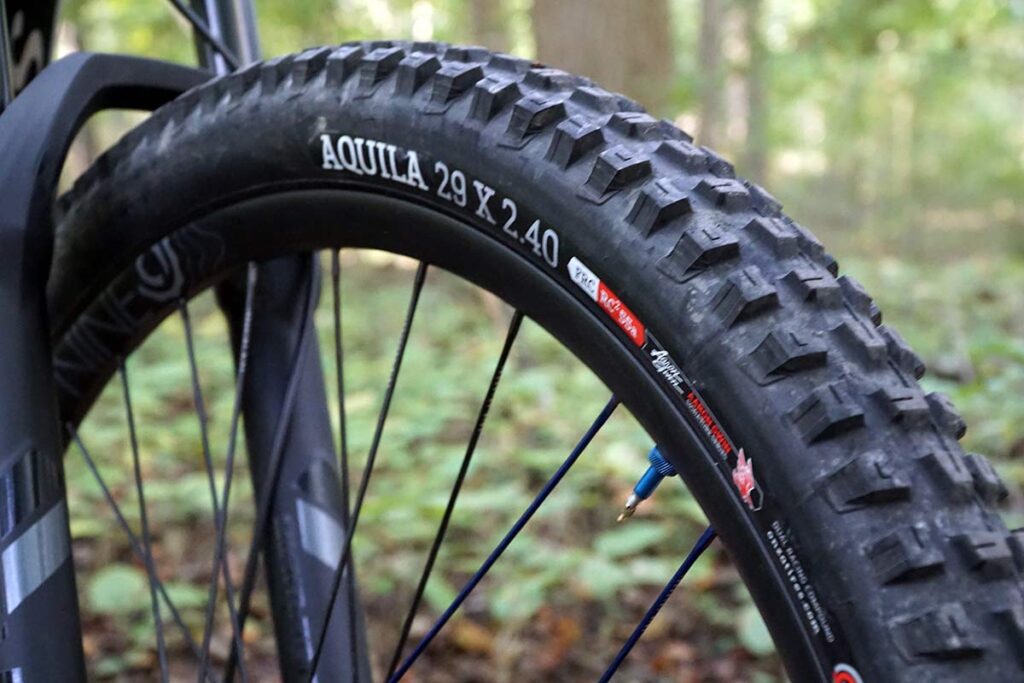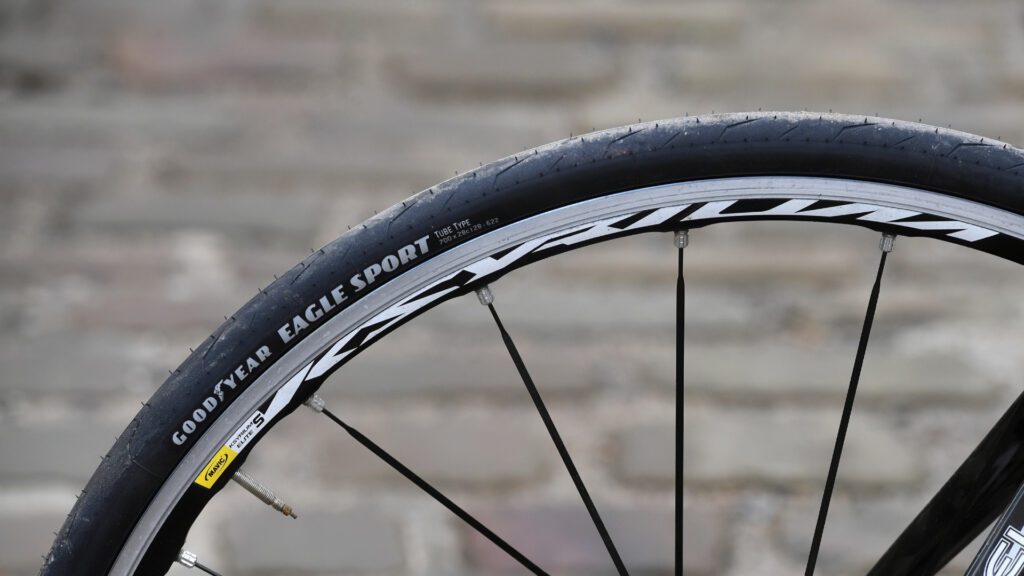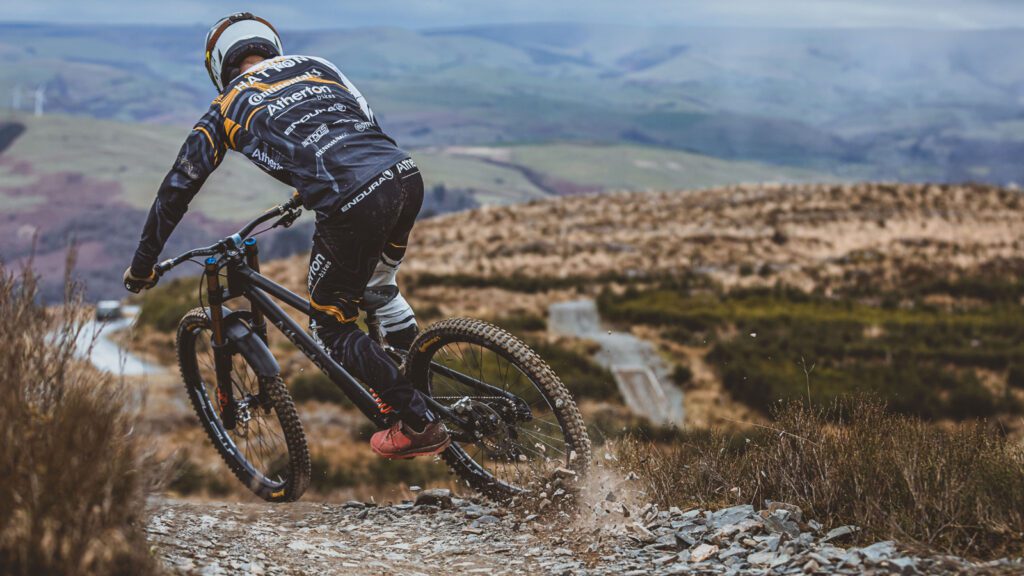


In the ever-evolving world of cycling, versatility often takes center stage. And one question that frequently arises in this context is, “Can you put road tires on a mountain bike?” This question arises from riders’ eagerness to transform their mountain bikes to accommodate diverse riding conditions, especially on smoother roads and paved pathways.
The answer to this question is a resounding “Yes”, you can put road tires on a mountain bike as long as the tire size matches the wheel size, and the frame provides sufficient clearance. This switch can improve road performance but sacrifices off-road traction.
In this exploration, we’ll navigate the terrain of tire compatibility, highlighting the advantages and considerations of fitting road tires onto a mountain bike frame. So, let’s embark on this journey of adaptability and discover how a simple tire swap can transform your mountain bike into a versatile, multi-terrain machine.
Read More: Why are gravel bikes so expensive
Things to Consider Before Installing Road Tires



Read More: How long should mountain bike tires last
Tire Compatibility:
Ensure that the road tires you intend to use have the same wheel size as your mountain bike. Most mountain bikes have 26-inch, 27.5-inch, or 29-inch wheels, so choose road tires that match your wheel diameter.
Frame Clearance:
Check if your mountain bike frame provides enough clearance for the road tires. Road tires are generally narrower than mountain bike tires, but there should still be sufficient space between the tires and the frame, fork, and brakes to prevent rubbing.
Riding Intent:
Consider your riding intentions. If you plan to use your mountain bike primarily on paved roads or smooth surfaces, road tires can enhance your speed and efficiency. However, if you still want to tackle off-road trails, opt for a tire that strikes a balance between on-road and off-road performance.
Tire Width:
Road tires come in various widths. Narrower road tires (e.g., 23mm or 25mm) are suitable for higher speeds on smooth roads, while wider road tires (e.g., 28mm or 32mm) offer more comfort and stability on rougher terrain.
Tire Pressure:
Adjust tire pressure according to the manufacturer’s recommendations. Road tires typically require higher pressure than mountain bike tires for optimal performance on paved surfaces.
Handling Differences:
Understand that road tires will significantly change the handling characteristics of your mountain bike. They offer less traction on loose surfaces, so be prepared for different cornering and braking behaviors.
Quick Release Consideration:
If your mountain bike has a through-axle or a different wheel attachment system, ensure that it’s compatible with the road wheelset or that you have the necessary adapters.
Tire Conversion Kits:
Some mountain bike manufacturers offer tire conversion kits that include narrower rims and road-specific tires. These kits can simplify the process of switching between road and off-road setups.
Wheelset Investment:
If you plan to use road tires frequently, consider investing in a dedicated road wheelset. This allows you to switch between wheelsets more easily and ensures better compatibility.
Experiment and Adapt:
Installing road tires is not a permanent commitment. Feel free to experiment with different tire sizes and tread patterns to find the setup that best suits your riding preferences.
In conclusion, installing road tires on your mountain bike can expand its versatility and make it more suitable for road riding. However, it’s essential to consider factors like compatibility, tire width, frame clearance and intended use to ensure a successful transition.
Whether you’re looking for increased speed on your daily commute or planning to explore diverse terrain, the right road tire setup can enhance your cycling experience.
What Size Road Tire Will Work on My MTB?



Mountain bikes are known for their versatility, allowing riders to conquer various terrains. However, if you’re looking to take your mountain bike on paved roads or smoother surfaces, swapping out your knobby off-road tires for sleek road tires can significantly improve your efficiency and speed.
But how do you determine the right size road tire for your MTB? In this guide, we’ll explore the key factors to consider to ensure a seamless transition to road-friendly tires.
Read More: Do mountain bike tires have tubes
Check Your Wheel Diameter
The first step in selecting road tires for your mountain bike is to match the tire size with your wheel diameter. Most mountain bikes come with 26-inch, 27.5-inch, or 29-inch wheels. You’ll need road tires that have the corresponding wheel diameter to ensure a proper fit.
For example, if your MTB has 27.5-inch wheels, opt for 27.5-inch road tires.
Consider Tire Width
Road tires come in various widths, and your choice should align with your riding preferences and terrain. Narrower road tires (e.g., 23mm or 25mm) are well-suited for smooth roads and offer lower rolling resistance, enhancing speed.
Wider road tires (e.g., 28mm or 32mm) provide more comfort and stability on rougher or uneven surfaces. Consider the type of riding you’ll be doing and select the width accordingly.
Check Frame and Fork Clearance
Once you’ve identified the right wheel diameter and tire width, the next critical consideration is frame and fork clearance. Road tires are generally narrower than mountain bike tires, so ensure that there is enough space between the tires and your frame, fork, and brakes to prevent rubbing. Check both the front and rear clearances.
Determine Your Riding Style
Your intended riding style plays a significant role in tire selection. If you plan to primarily ride on smooth, paved roads, narrower road tires are a suitable choice for increased speed. However, if you still want the flexibility to tackle occasional off-road trails, consider wider road tires with a more balanced tread pattern to maintain some off-road capability.
Test and Experiment
Choosing the right road tire size may involve some trial and error. Start with a size you believe will work for your riding style, but don’t hesitate to experiment with different sizes and tread patterns to find the setup that best suits your preferences. This flexibility is one of the advantages of switching to road tires on an MTB.
Consult with a Professional
If you’re unsure about the compatibility of road tires with your specific mountain bike model, consider consulting with a local bike shop or a professional mechanic. They can provide guidance based on your bike’s specifications and your intended use.
In conclusion, finding the right size road tire for your mountain bike involves matching the wheel diameter, considering tire width, checking frame and fork clearance, and aligning your choice with your riding style.
With the right road tire setup, you can transform your MTB into a versatile machine capable of delivering a smooth and efficient ride on paved roads while preserving the option to explore diverse terrain when the adventure calls.
How to Choose the Perfect Road Tires



Mountain bikes are renowned for their off-road prowess, but what if you want to explore the world of paved roads and smooth surfaces without investing in a separate road bike? The answer lies in swapping out your knobby mountain bike tires for sleek road tires.
This transformation can elevate your MTB into a versatile machine, perfect for speedy commutes and long road rides. But how do you choose the right road tires for your MTB? In this guide, we’ll steer you through the essential factors to consider to ensure a seamless transition to road-friendly tires.
Determine Your Riding Goals
The first step in selecting road tires for your mountain bike is to define your riding goals. Are you primarily using your MTB for commuting, long-distance road rides, or a mix of both? Understanding your intended use will help you narrow down your tire choices.
Match the Wheel Diameter
One of the most crucial aspects of selecting road tires is matching the wheel diameter of your mountain bike. Most MTBs come with 26-inch, 27.5-inch, or 29-inch wheels. Make sure to choose road tires with the same wheel diameter to ensure a proper fit and optimal performance.
Consider Tire Width
Road tires come in a range of widths, each offering distinct advantages. Narrower road tires (typically 23mm to 28mm) are designed for speed and reduced rolling resistance on smooth roads. Wider road tires (ranging from 28mm to 32mm or more) provide increased comfort and stability, making them ideal for rough or uneven surfaces.
Consider your riding terrain and preferences when selecting the width.
Check Frame and Fork Clearance
Before making your final choice, examine your MTB’s frame and fork clearance. Road tires are generally narrower than mountain bike tires, so ensure that there is adequate space between the tires and your frame, fork, and brakes. Proper clearance is essential to prevent rubbing and ensure a safe and efficient ride.
Tread Pattern and Grip
While road tires are designed for smooth surfaces, it’s essential to consider the tread pattern and grip. If you plan to encounter wet or slippery conditions, look for road tires with a tread pattern that provides a reliable grip. For mostly dry road riding, smoother tread patterns will suffice.
Puncture Protection
Road tires often include features like puncture protection belts or layers to reduce the risk of flats. If puncture resistance is a concern, opt for road tires with enhanced protective features.
Tire Pressure
Proper tire pressure is crucial for road riding. Road tires generally require higher pressure than mountain bike tires. Refer to the manufacturer’s recommendations for the optimal tire pressure, which can improve both efficiency and comfort on the road.
Experiment and Adjust
Selecting the perfect road tires may require some experimentation. Start with a size and width that aligns with your riding goals, but don’t hesitate to adjust and try different options to find the setup that best suits your preferences.
Read More: How to build a gravel bike
In conclusion, choosing the right road tires for your mountain bike is a fantastic way to expand your riding horizons. By considering your riding goals, matching the wheel diameter, selecting the appropriate width, ensuring proper clearance, and evaluating tread patterns and puncture protection, you can unlock your MTB’s potential for road adventures.
With the right road tire setup, you’ll be ready to tackle the pavement with speed, comfort, and confidence, all while preserving the versatility to return to the trail when the call of the outdoors beckons.
Will a Road Tire Make My MTB Go Faster?



Mountain biking thrills with its rugged terrains and off-road adventures, but what if you’re yearning for speed on smoother surfaces? Swapping your knobby mountain bike tires for sleek road tires can be a game-changer.
It’s a modification that transforms your MTB into a speed demon, but does it really make your mountain bike go faster? In this article, we’ll delve into the mechanics of road tires and how they can help you unlock new levels of speed and efficiency on your mountain bike.
Reduced Rolling Resistance
One of the primary reasons road tires can make your MTB go faster is their significantly reduced rolling resistance. Unlike the aggressive tread patterns of mountain bike tires, road tires feature a smoother, slicker surface that minimizes friction with the road.
This means less effort is required to keep your bike moving, translating to increased speed on paved roads.
Enhanced Aerodynamics
Road tires are typically narrower than mountain bike tires, which plays a role in improving your bike’s aerodynamics. The reduced air resistance allows you to cut through the air more efficiently, especially when riding at higher speeds.
This aerodynamic advantage can noticeably boost your cruising speed on the road.
Optimal Tire Pressure
Road tires often require higher tire pressure compared to mountain bike tires. The higher pressure provides a more rigid tire, reducing the contact patch with the road. This, in turn, reduces rolling resistance and enhances speed.
However, it’s crucial to maintain the recommended tire pressure for safety and performance.
Smoother Ride
Road tires also provide a smoother and more comfortable ride on paved surfaces. Their design is tailored to absorb less road vibration, reducing fatigue during longer rides. A more comfortable ride can indirectly contribute to increased speed as you can maintain your pace for more extended periods.
Versatility for Mixed Terrain
While road tires excel on smooth roads, their versatility extends to mixed terrain as well. If your ride includes both paved and gravel sections, road tires can handle the transition effectively, ensuring you maintain your speed on various surfaces.
Considerations and Trade-offs
While road tires can enhance your MTB’s speed on smooth surfaces, it’s essential to consider the trade-offs. They provide less traction on loose or wet terrain, making them unsuitable for off-road adventures.
Additionally, the reduced tire width may result in a harsher ride on rough roads or potholed surfaces.
In conclusion, road tires can undeniably make your mountain bike go faster on paved roads. The combination of reduced rolling resistance, improved aerodynamics, and optimal tire pressure can lead to significant gains in speed and efficiency.
However, it’s essential to weigh the advantages against the limitations and consider your riding goals. If you’re primarily focused on road riding and speed, the switch to road tires can be a transformative upgrade that unleashes your MTB’s full potential for thrilling, high-speed adventures on smooth surfaces.
Balancing Speed and Versatility: Road Tires for Mixed Terrain Riding



As a cyclist, the allure of the open road and the thrill of off-road adventures both hold their unique appeal. But what if you don’t want to be confined to just one terrain? Enter road tires for mixed-terrain riding. These versatile rubber companions offer a dynamic blend of speed and adaptability, allowing you to explore everything from smooth city streets to gravel paths and even light trails.
In this guide, we’ll embark on a journey to understand how road tires designed for mixed terrain can help you strike the perfect balance between velocity and versatility.
The Need for Versatility
Mixed terrain riding is all about variety and exploration. You might find yourself cruising through your city’s streets one moment and venturing onto a scenic gravel path the next. It’s this diversity that makes mixed-terrain riding so appealing, but it also poses a challenge when it comes to tire selection.
Enter Road Tires for Mixed Terrain
Road tires designed for mixed-terrain riding are engineered to tackle a broad spectrum of surfaces. Here’s how they achieve this balance:
1. Tread Patterns
These tires often feature a hybrid tread pattern. While they may not be as knobby as mountain bike tires, they have enough grip and traction to handle gravel and packed dirt. The center tread is typically smoother, optimizing road performance, while the side knobs provide stability on mixed surfaces.
2. Wider Widths
Compared to traditional road tires, mixed terrain road tires are wider. This added width offers stability and comfort on uneven terrain while still maintaining lower rolling resistance than mountain bike tires.
3. Lower Pressure Tolerance
Mixed-terrain road tires can handle lower tire pressures compared to road-specific tires. This means you can fine-tune the tire pressure to suit the terrain you’re riding on. Lower pressure enhances grip on loose surfaces while sacrificing minimal efficiency on the road.
Balancing Act: Speed and Comfort
The true beauty of road tires for mixed terrain lies in their ability to find the sweet spot between speed and comfort:
- Speed on the Road:
On smooth pavement, these tires offer excellent speed and efficiency. The smoother center tread minimizes rolling resistance, allowing you to maintain higher speeds with less effort.
- Versatility Off-Road:
When you venture off-road, the wider profile and hybrid tread come into play. They provide the traction and stability needed to tackle gravel, hard pack, and even light trails.
- Comfort Throughout:
Perhaps most importantly, these tires provide a comfortable ride across various terrains. They absorb vibrations and irregularities, reducing rider fatigue on long mixed-terrain journeys.
Road tires designed for mixed-terrain riding open up a world of possibilities for cyclists who crave both speed and versatility. With these tires, you’re not limited to just one type of riding. You can explore urban streets, venture onto gravel paths, and even tackle gentle trails, all with the same set of tires.
It’s a true balancing act that allows you to embrace the diverse landscapes that cycling has to offer. So, equip your bike with road tires for mixed-terrain riding, and get ready to experience the best of both worlds.
Maintenance Tips: Keeping Your Road Tires Performing at Their Best



Road Tires are your ticket to a smooth and speedy ride on paved surfaces. Whether you’ve recently made the switch from knobby mountain bike tires or you’re a seasoned road cyclist, maintaining your road tires is essential to ensure they deliver top-notch performance.
In this guide, we’ll explore maintenance tips that will keep your road tires in optimal condition, so you can enjoy the benefits of speed and efficiency mile after mile.
Proper Inflation
Maintaining the correct tire pressure is crucial for road tire performance. Check the recommended pressure range specified on the tire sidewall and use a high-quality gauge to ensure your tires are adequately inflated.
Under-inflated tires can increase rolling resistance, making your ride sluggish, while over-inflated tires may compromise grip and comfort.
Regular Inspections
Make it a habit to visually inspect your road tires before each ride. Look for any signs of wear, cuts, or embedded debris. Small stones or glass shards can cause punctures if left unnoticed. Remove foreign objects and address any damage promptly.
Tire Rotation
To ensure even wear, consider rotating your road tires regularly. This practice extends their lifespan and maintains consistent performance. Swap the front and rear tires every few hundred miles or as needed, depending on your riding style and conditions.
Cleaning and Maintenance
Road tires can accumulate road grime, dust, and debris, which can affect their performance. Periodically clean your tires with a mild soapy solution and a soft brush. Rinse thoroughly and let them dry before your next ride.
Avoid using harsh chemicals or abrasive materials that can damage the tire surface.
Tire Sealant and Puncture Protection
Consider using tire sealant or liners to provide an extra layer of puncture protection. These products can help seal small punctures on the road, preventing flats and extending the life of your tires. Follow the manufacturer’s recommendations for application.
Avoiding Hazardous Terrain
While road tires excel on smooth roads, avoid riding on surfaces with sharp gravel, broken glass, or other debris that can increase the risk of punctures or damage. Be mindful of your route selection to minimize potential hazards.
Tire Storage
If you plan to store your road bike for an extended period, consider removing the tires and storing them separately in a cool, dry place. This helps prevent flat spots and maintains the tire’s shape.
Professional Inspection
For peace of mind and a thorough assessment of your road tires’ condition, consider scheduling regular professional inspections at your local bike shop. Trained technicians can identify potential issues and recommend appropriate maintenance or replacements.
Road tires are a key component in optimizing your road cycling experience. By following these maintenance tips, you can keep your road tires performing at their best, ensuring a smooth and efficient ride every time you hit the pavement.
Regular care and attention to your tires will not only extend their lifespan but also enhance your safety and enjoyment on the road. So, roll confidently, knowing your road tires are well-maintained and ready for the miles ahead.
Conclusion:
Summing it up, the answer to the query “Can you put road tires on a mountain bike?” is a resounding yes. The versatility of modern mountain bikes allows you to adapt them for various terrains, including paved roads.
By making the switch to road tires, you can unlock a world of speed and efficiency while still retaining the flexibility to explore mixed terrain when the adventure beckons.
It’s a transformation that brings a new dimension to your cycling experience, allowing you to balance the thrill of speed with the versatility to conquer different landscapes.
So, if you’re pondering the switch, remember that your mountain bike can indeed wear road tires, offering you the best of both worlds.\
FAQs:
Are road tires compatible with all mountain bike wheel sizes?
Road tires are available in various sizes to match different mountain bike wheel sizes. It’s important to choose road tires that match your mountain bike’s wheel diameter, such as 26-inch, 27.5-inch, or 29-inch road tires.
What are the advantages of using road tires on a mountain bike?
The advantages of using road tires on a mountain bike include increased speed on smooth surfaces, reduced rolling resistance for better efficiency, and a smoother, more comfortable ride. They also provide versatility for mixed terrain riding.
Do I need to change my mountain bike rims to use road tires?
In most cases, you don’t need to change your mountain bike rims to use road tires. As long as the road tires match your wheel diameter and there is sufficient frame clearance, you can typically install road tires on your existing rims.
Can I switch between road and mountain bike tires easily?
Yes, you can switch between road and mountain bike tires relatively easily. However, it’s essential to ensure that your frame provides adequate clearance for both tire types, and you may need to adjust tire pressure to optimize performance.
What tire pressure should I use for road tires on my mountain bike?
The recommended tire pressure for road tires on a mountain bike can vary depending on the tire size and weight. It’s generally advisable to stay within the manufacturer’s recommended pressure range, which is typically higher than that of mountain bike tires. This ensures proper performance on paved roads.



Welcome to Bikegenics, where passion meets performance! We are a leading online destination for all things related to mountain biking, dedicated to providing you with top-notch gear, expert advice, and an immersive community to fuel your two-wheeled adventures. With a commitment to excellence and a deep love for the sport, we strive to elevate your biking experience to new heights.
